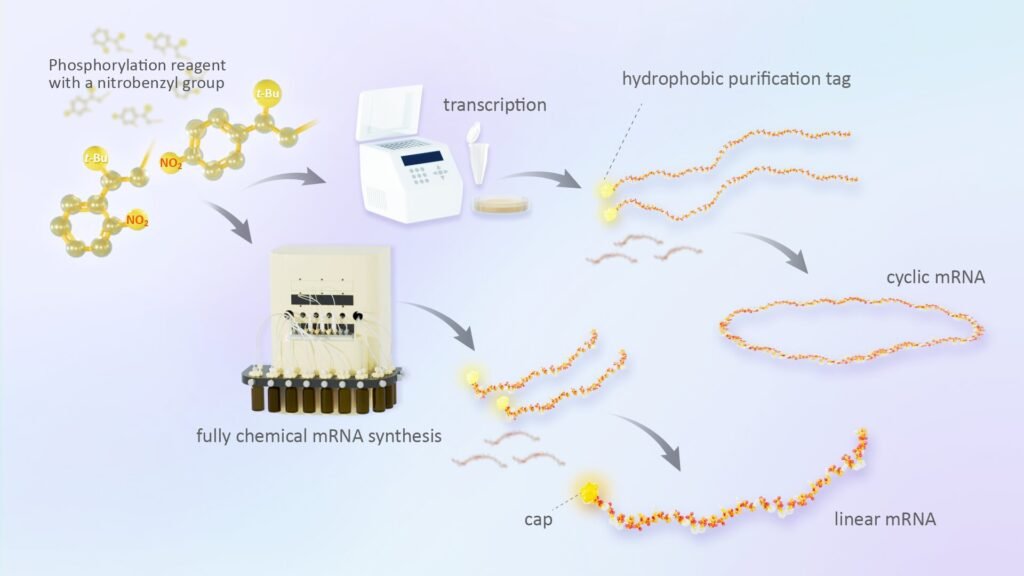A phosphorylation reagent with a nitrobenzyl hydrophobic tag enables the production of highly pure fully chemically synthesized mRNA and transcriptionally synthesized circular mRNA. Credit: Reiko Matsushita
In an era when viral outbreaks can develop into global pandemics with alarming speed, the ability to rapidly develop new vaccines is critical. However, there are limits to how quickly vaccines can be produced because some of the mRNA used in vaccines is synthesized chemically and some using enzymes, which is a relatively slow process.
A research team at Nagoya University in Japan has successfully developed an innovative synthesis technique that eliminates slow enzymatic reactions and can produce highly pure, fully chemically synthesized mRNA.
This progress is expected to establish the foundation for a more rapid response to viral outbreaks and emerging diseases, leading to early stage mitigation of future infectious diseases. Their results were published in the journal Nucleic Acids Research.
Given its important role in the fight against the COVID-19 pandemic, mRNA is now widely recognized to have the potential to help prevent infectious diseases. Experts predict that in the future, mRNA technology will be used to treat genetic and emerging diseases. However, mRNA production remains challenging due to concerns regarding purity and production rates.
These issues can be resolved using fully chemically synthesized mRNA. According to Masato Inagaki, “One of the most important advantages of fully chemically synthesized mRNA is that it avoids the complex and time-consuming enzymatic reactions normally required for the production of mRNA. The generation time is significantly reduced for methods that rely on the “ process. “
It also benefits people who have a strong immune response to the vaccine. mRNA derived from 5′-monophosphorylated RNA is susceptible to contamination with incomplete RNA fragments and elicits strong immune responses. This immune response increases the risk of side effects, especially inflammation. However, existing purification techniques struggle to remove these impurities, limiting their potential.
To address these issues, Professor Hiroshi Abe, PhD student Mami Ototake, Assistant Professor Inagaki, and colleagues devised a new phosphorylation reagent with a nitrobenzyl group that functions as a hydrophobic purification tag.
Professor Inagaki says, “Nitrobenzyl groups are highly hydrophobic, so introducing nitrobenzyl groups into RNA molecules increases the hydrophobicity of mRNA. Impure RNA does not have nitrobenzyl groups, so It can be easily isolated using target RNA and reverse reaction.” -phase high performance liquid chromatography.
“This approach yields pure RNA, free of length mismatches and impurities typically associated with transcription-based synthesis methods.”
In addition to fully synthesizing mRNA chemically, the team also used the same method to create pure circular mRNA. Circular mRNA is characterized by having no terminal structure and is resistant to degradation by nucleolytic enzymes in the body, resulting in longer-lasting drug efficacy.
Breakthroughs in mRNA production have profound implications for the future of medicine. “This innovation paves the way for highly efficient production of fully chemically synthesized mRNA and circular mRNA, potentially revolutionizing RNA drug discovery and expanding the scope of mRNA-based therapeutics.” Mr. Abe said.
Faster and purer vaccine production should reduce response times to future infectious disease threats. In the future, the research team hopes to use these results to develop new mRNA vaccines against cancer antigens and genetic diseases.
Further information: Mami Ototake et al., Development of hydrophobic tags to purify monophosphorylated RNA for chemical synthesis of capped mRNA and enzymatic synthesis of circular mRNA, Nucleic Acids Research (2024). DOI: 10.1093/nar/gkae847
Provided by Nagoya University
Citation: mRNA vaccines against disease outbreaks can be synthesized faster with new technology (October 16, 2024) from https://phys.org/news/2024-10-mrna-vaccines-disease-outbreaks-technique Retrieved October 17, 2024.html
This document is subject to copyright. No part may be reproduced without written permission, except in fair dealing for personal study or research purposes. Content is provided for informational purposes only.

